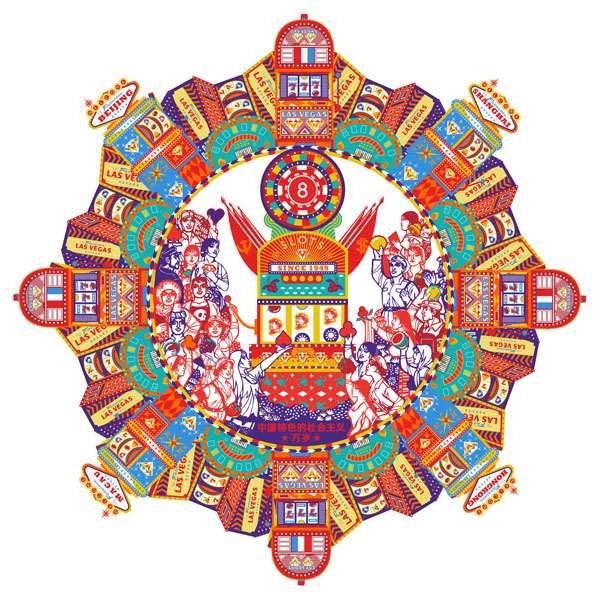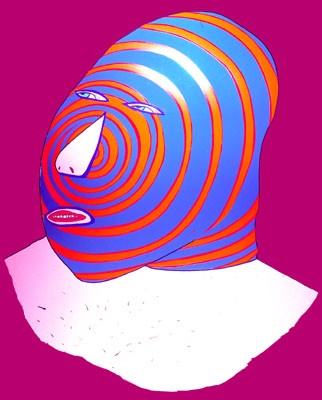‘Pop Art’ is an enduring art movement which emerged in the 1950s, and significantly remains a major influence on contemporary artists today. While Pop Art is generally associated with American commercialisation, and New York artists such as Roy Lichtenstein, Robert Rauschenberg, Andy Warhol and Jasper Johns, notably, the movement and its ideals were originally founded in Britain.
In the wake of the war as Britain was struggling with a financially crippled nation, its artists turned to the new consumerist paradise that was post-war America - looking longingly and critically at the bright and happy imagery emerging out of the US primarily through the medium of advertisement. As early as 1947, Scottish sculptor and artist Eduardo Paolozzi was creating collages from imagery he had found in American consumer magazines and comic strips - including images of American cars, and brands such as Dr Pepper, SPAM, and Mickey Mouse.
Peter Blake, today considered one of the foremost British Pop Artists, borrowed heavily from the marketing language of America, moving away from traditional subject matter and stretching the parameters of what constituted art. Both Paolozzi and Blake wanted to reject what they saw as an ‘elitist hold’ on British art, and make way for art that was fresh, optimistic, relevant and most importantly, accessible to everyone.
_2005.jpg)
PETER BLAKE
Fag Packets (Belga), 2005
Edition of 95
76(w) x 101(h) cm
29.92(w) x 39.76(h) inches
_2005.jpg)
PETER BLAKE
Fag Packets (Belga), 2005
Edition of 95
76(w) x 101(h) cm
29.92(w) x 39.76(h) inches
|
|
|
76(w) x 101(h) cm
29.92(w) x 39.76(h) inches
|
From the series of 'Fag Packets' from 2004-2005.
Screenprint on Somerset satin paper.
Signed and numbered on front.
Edition of 95
|
PRICE
|
£ 2,500.00
|
|
Available from a private collection
|
|
From these early beginnings in Britain, Pop Art then flourished as a movement in 1960s New York. Rejecting the complexity and ambiguity of Abstract Expressionist art, American Pop Artists took an opposite approach, reintroducing recognisable imagery including celebrities, comic books, logos and brands, which required little or no interpretation from the viewer. Visually, Pop Art was bright and bold, and used simplified forms, repetition, symbols, and reproductions. Pop Artists also broke new ground with their techniques, using mass production processes such as screen-printing, which had previously been associated with design and advertising - not fine art.
Andy Warhol, perhaps the most famous Pop Artist in art history, was also a highly successful magazine illustrator and graphic designer. Beginning his career in commercial art, Warhol was trained in the visual vocabulary of mass culture and was therefore able to utilise his design skills to merge the boundaries of high art and popular culture. Warhol’s series of the late Marilyn Monroe was the artist’s first series using the method of screen-printing where he was able to churn out a number of versions of the same image, much like a printing press or factory-line, in order to make a comment on the cult of the celebrity and Marilyn Monroe’s ever-presence in the media.
Pop Art was a break-through movement for its time, blurring the lines of high and low art, and debunking the idea that there was any hierarchy of culture. However, what is truly unique about the movement is its enduring quality, and continued relevance so many years later.

JACKY TSAI
Long Live Socialism with Chinese Characteristics I, 2016
Edition of 50
83(w) x 83(h) cm
32.68(w) x 32.68(h) inches

JACKY TSAI
Long Live Socialism with Chinese Characteristics I, 2016
Edition of 50
83(w) x 83(h) cm
32.68(w) x 32.68(h) inches
|
|
|
83(w) x 83(h) cm
32.68(w) x 32.68(h) inches
|
Screenprint with glow in the dark ink and unique chip number on Somerset 410 gsm paper. Hand torn edge
Edition of 50
|
PRICE
|
£ 3,800.00
|
|
Available from a private collection
|
|
Exploring some of Eyestorm’s contemporary artists, we can see the way Pop Art has saturated so much of the creative work being produced today. Artists such as
Jacky Tsai,
Brian Jones, and
Peter Lloyd all nod to the original Pop Art movement through both their borrowing of contemporary cultural imagery, and their artistic techniques, which utilise screen-printing, collage, and bright, bold palettes. Works such as Jacky Tsai’s
Chinese Gamble have a particular ‘Pop Art’ style, using simple, recognisable imagery, repeated over and over again. In this work the repetition of the bank notes, and slot machines in simple, bold colours, reflect the way casino’s hypnotise their customers with bright and confusing imagery. As seen in the original Pop Art movement, contemporary works such as ‘Chinese Gamble’ and the print edition
Long Live Socialism with Chinese Characteristics I from 2016, satirize cultural norms and make simple but effective comments about the now - keeping Pop Art relevant to today.
Perhaps one of the most telling examples of how Pop Art has influenced today’s artists is by looking at the work of one of the biggest names, and highest selling contemporary artists of today -
Jeff Koons. Categorised as a ‘Neo-Pop’ artist Koons borrows his images from contemporary kitsch culture - anything from blow-up balloon animals and cartoons, to the iconic Hoover brand. It is hard not to see the similarities between Jeff Koon’s studio filled with assistant’s mass-producing his art, and Andy Warhol’s original New York ‘art factory’ of the same kind. With Koon’s work now fetching several million dollars at auction and in the collections of most major contemporary art museums including the Museum of Modern Art, New York, and the Tate Modern, London, there is no denying the continuing appetite for contemporary ‘Pop’ art in the market. Decades after the original movement, with the rise of the internet and social media, and the introduction of digital technologies, Pop Art ideology is perhaps more pertinent today than it ever has been, and it continues to remain one of the most successful styles of art on the market - a seemingly unbreakable movement.

PETER LLOYD
Hecho En Mexico, 2000
70(w) x 100(h) cm
27.56(w) x 39.37(h) inches

PETER LLOYD
Hecho En Mexico, 2000
70(w) x 100(h) cm
27.56(w) x 39.37(h) inches
|
|
|
70(w) x 100(h) cm
27.56(w) x 39.37(h) inches
|
|
|
You can see more work by
Peter Blake,
Brian Jones,
Jeff Koons,
Peter Lloyd and
Jacky Tsai on their artist pages.